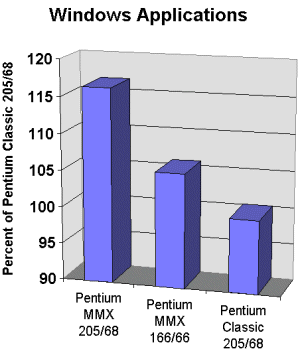Does the Pentium MMX Live up to the Expectations?
Introduction
15 days after its official release I eventually received my very own Pentium MMX 200. It was actually a kind donation of Erik Wagner from Nutek Systems USA, IL. I installed it on my system and it it ran straight away without any problems even at 208/83, 225/75 and 250/83 MHz. I am currently using it on my ABIT IT5V at 225/75 MHz with 64 MB SDRAM.
Before you start bombarding me with emails, asking why I used 205/68 instead of 200/66, or 166/66 instead of 171/86, I would like to explain the reason for it. I wanted to show most impressingly, that under some conditions the Pentium MMX 166 is even faster than a slightly tuned Pentium Classic 200 at 205/68. Hence I used the slowest Pentium MMX to compete against the fastest official Pentium Classic at turbo frequency.
Windows Applications
| Benchmark(System: ABIT IT5V, 32 MB SDRAM, Diamond Stealth 64 Video VRAM w/2 MB) | Pentium MMX205/68 | Pentium Classic205/68 | Pentium MMX166/66 |
|---|---|---|---|
| Business Winstone 97 (@1024x768x256x60) | 44.3 | 40.1 | 41.2 |
| High-End Winstone 97 (@1024x768x256x60) | 19.5 | 17.3 | 17.5 |
| Business Graphics Winmark 97 (@1024x768x65536x75) | 55.1 | 45.1 | 49.8 |
| High-End Graphics Winmark 97 (@1024x768x65536x75) | 28.6 | 24.2 | 25.3 |
For people who are using lots of Windows business applications, the Pentium MMX is certainly worth getting. Even the Pentium MMX 166 is already 5% faster than a maxed out Pentium Classic 200 at 205/68 MHz.
| Direct3D Tunnel Benchmark RAMP (@640x480x256) [fps] | 18.6 | 18.7 | 15.0 |
| Direct3D Tunnel Benchmark RGB (@640x480x256) [fps] | 9.0 | 4.1 | 7.6 |
| Direct3DTest RAMP - Fill Rate [mpps] | 5.89 | 5.41 | 5.09 |
| Direct3DTest RAMP - Polygon Throughput [kpps] | 150.29 | 142.00 | 133.25 |
| Direct3DTest RAMP - Intersection Throughput [kpps] | 1.23 | 1.19 | 1.04 |
| Direct3DTest RGB - Fill Rate [mpps] | 5.41 | 1.46 | 4.57 |
| Direct3DTest RGB - Polygon Throughput [kpps] | 165.17 | 172.37 | 139.18 |
| Direct3DTest RGB - Intersection Throughput [kpps] | 1.00 | 0.32 | 0.84 |
| Direct3D FlipCube Benchmark - RAMP (@640x480x256) [fps] | 76 | 76 | 76 |
| Direct3D FlipCube Benchmark - RGB (@640x480x256) [fps] | 76 | 49 | 76 |
| Direct3D Twist Benchmark - RAM (@640x480x256) [fps] | 42.0 | 42.0 | 38.5 |
| Direct3D Twist Benchmark - RGB (@640x480x256) [fps] | 26.0 | 16.0 | 22.0 |
| Winbench 97 DirectDraw/Animate Screen Size 1280x1024 [pixels drawn] | 42.4 | 35.6 | 38.3 |
| Winbench 97 DirectDraw/Fill Color Depth 8 Bit Color [pixels drawn] | 252 | 252 | 252 |
Get Tom's Hardware's best news and in-depth reviews, straight to your inbox.
-
remingtonh Crysis was designed to take full advantage of the NEW MMX instructions. Intel MMX technology - see it, hear it, experience it.Reply
